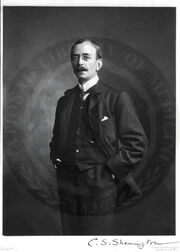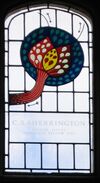Assessment |
Biopsychology |
Comparative |
Cognitive |
Developmental |
Language |
Individual differences |
Personality |
Philosophy |
Social |
Methods |
Statistics |
Clinical |
Educational |
Industrial |
Professional items |
World psychology |
Biological: Behavioural genetics · Evolutionary psychology · Neuroanatomy · Neurochemistry · Neuroendocrinology · Neuroscience · Psychoneuroimmunology · Physiological Psychology · Psychopharmacology (Index, Outline)

Sherrington is considered one of the fathers of neuroscience.
Sir Charles Scott Sherrington OM GBE, (November 27, 1857 – March 4, 1952) was a British neuroscientist known for his contributions to physiology and neuroscience. He shared the 1932 Nobel Prize in Physiology or Medicine with Edgar Douglas Adrian for "for their discoveries regarding the functions of neurons".[1]
Research[]
Sherrington used reflexes in the spinal cord as a way of investigating the general properties of neurons and the nervous system. These experiments led him to postulate "Sherrington's law of reciprocal innervation," which states that for every neural activation of a muscle, there is a corresponding inhibition of the opposing muscle. Sherrington is also known for his study of the synapse, a word which he coined for the then-theoretical connecting point of neurons. One of Sherrington's students, John Carew Eccles later won the Nobel Prize in 1963 for his work on the synapse. Other neuroscience research done by Sherrington investigated proprioception and the neural control of posture.
In addition to the nervous system, Sherrington studied a number of pressing medical issues of his time. In 1885 he went to Spain to investigate an outbreak of cholera. Sources differ as to whether Sherrington met Santiago Ramon y Cajal at this time. Although the official Nobel Prize biography of Sherrington mentions this meeting,[2] Sherringtion himself denied it in his euology of Cajal. Sherrington claimed the only meeting between them occurred when Cajal visited England, at Sherrington's invitation, to deliver the 1894 Croonian Lecture. Sherrington learned techniques in bacteriology and histology from Robert Koch while studying an outbreak of cholera in Berlin.
Biography[]

Stained glass window in the dining hall of Caius College, in Cambridge, commemorating C.S. Sherrington.
Sherrington was born in London, England. He studied physiology under Sir Michael Foster at Cambridge University. In 1887 Sherrington joined the faculty of St Thomas's medical school. In 1895, he became a professor at the University of Liverpool. He took over the Waynflete Professorship in Physiology at Oxford University in 1913. He served as president of the Royal Society from 1920 to 1925. Sherrington received the Knight Grand Cross of the British Empire in 1922 and the Order of Merit in 1924. Sherrington retired from Oxford in 1935, but continued to lecture and write. He died in Eastbourne, Sussex.
Sherrington Crater was named after him by the International Astronomical Union. As is one of The University of Liverpool's buildings which houses Medical Teaching lecture theatres, Undergraduate Pharmacology and Physiology laboratory's as well as a Human Anatomy research centre (HARC).
Bibliography[]
- The Integrative Action of the Nervous System New York, Charles Scribner's Sons, 1906
- Mammalian physiology. Oxford and London, 1919.
- The Reflex Activity of the Spinal Cord Oxford, 1932.
- The Brain and Its Mechanism. Cambridge, 1933
- Man on His Nature The Gifford lectures, Edinburgh: New York: MacMillan, 1937-1938.
- Nobel Lectures, Physiology or Medicine 1922-1941, Elsevier Publishing Company, Amsterdam, 1965.
References[]
- ↑ The Nobel Prize in Physiology or Medicine 1932: Nobelprize.org Website. Retrieved 2 JUne 2006
- ↑ Sir Charles Sherrington – Biography: Nobelprize.org website. Retrieved 2 June 2006.
External links[]
| Preceded by: Sir J. J. Thomson |
President of the Royal Society 1920–1925 |
Succeeded by: The Lord Rutherford of Nelson |
Nobel Laureates
in Physiology or Medicine |
|---|
|
Johannes Fibiger (1926) • Julius Wagner-Jauregg (1927) • Charles Nicolle (1928) • Christiaan Eijkman / Frederick Hopkins (1929) • Karl Landsteiner (1930) • Otto Warburg (1931) • Charles Sherrington / Edgar Adrian (1932) • Thomas Morgan (1933) • George Whipple / George Minot / William Murphy (1934) • Hans Spemann (1935) • Henry Dale / Otto Loewi (1936) • Albert Szent-Györgyi (1937) • Corneille Heymans (1938) • Gerhard Domagk (1939) • Henrik Dam / Edward Doisy (1943) • Joseph Erlanger / Herbert Gasser (1944) • Alexander Fleming / Ernst Chain / Howard Florey (1945) • Hermann Muller (1946) • Carl Cori / Gerty Cori / Bernardo Houssay (1947) • Paul Müller (1948) • Walter Hess / Egas Moniz (1949) • Edward Kendall / Tadeusz Reichstein / Philip Hench (1950) |
|
Complete roster | (1901-1925) | (1926-1950) | (1951-1975) | (1976-2000) | (2001-2025) |
| This page uses Creative Commons Licensed content from Wikipedia (view authors). |